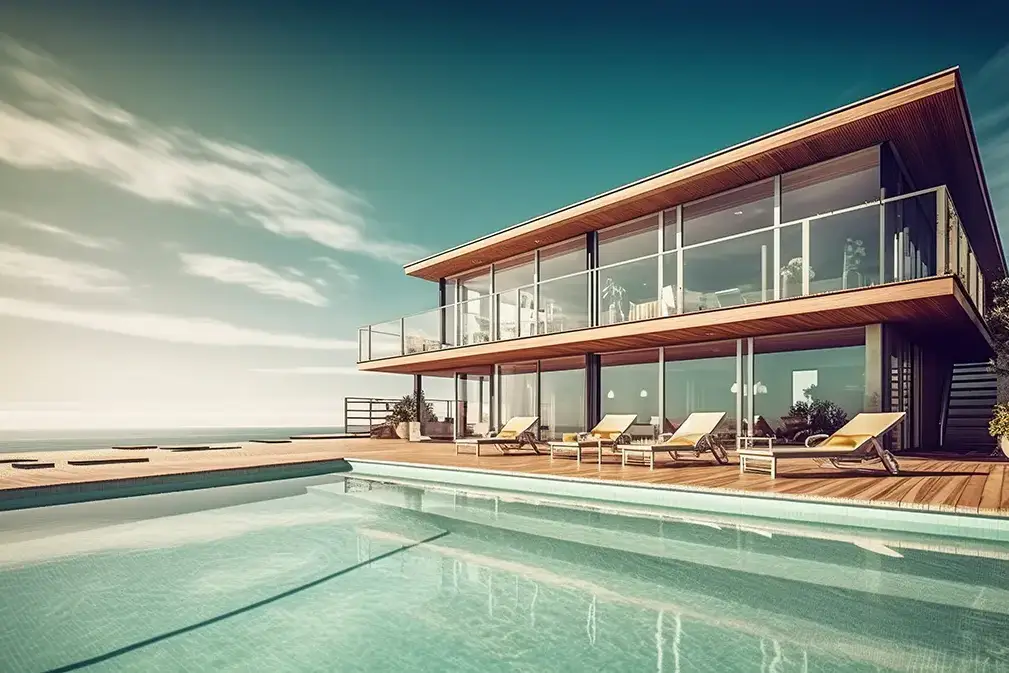Radiant floor heating is an efficient and comfortable heating system. It operates by channeling water through pipes beneath the flooring, turning the floor into a uniform heat emitter. This system offers advantages in consumption, comfort, and environmental respect. There are two main types of radiant floor heating: hot water and electric. Installation requires specific components for optimal operation. Discover everything about how radiant floor heating works in our article. La Quinta Fachada.
Radiant Floor Heating
Radiant floor heating is an efficient and comfortable heating system based on the channeling of water or electricity beneath the floor of a home, business, or commercial space. It functions as a low-temperature thermal emitter that is homogeneously distributed, providing superior thermal comfort and enhancing the environmental experience.
How Radiant Floor Heating Works
Radiant floor heating operates by channeling hot water or electricity through a system of pipes or wiring distributed beneath the flooring. In the case of water-based radiant floor systems, hot water is pumped through a piping circuit, while in the electric system, heat is distributed via conductive wiring.
Advantages of Radiant Floor Heating
- Greater thermal comfort: due to its homogeneous operation, radiant floor heating provides a comfortable sensation throughout the space.
- Lower energy consumption: thanks to its low-temperature operation, radiant floor heating allows for significant energy consumption savings.
- Environmentally friendly: as it can be powered by renewable energy sources like aerothermal energy, radiant floor heating is a more sustainable option.
Water-Based Radiant Floor System
The water-based system uses a circuit of pipes that distributes hot water under the flooring. This system can be powered by different energy sources, such as natural gas or aerothermal energy, allowing it to operate with renewable energies sustainably.
Electric Radiant Floor System
In the electric radiant floor system, heat is distributed through conductive wiring located beneath the flooring. Although this system has a lower installation cost, it’s important to consider that it tends to generate higher electricity consumption.
Radiant Floor Installation
Installing a radiant floor system requires placing several components, such as an insulating plate, plastic pipes, a perimeter band, and a mortar coating. These components ensure that the system operates optimally and efficiently, providing the aforementioned advantages.
Radiant Floor and Aerothermal Energy
Radiant floor heating can operate efficiently and sustainably when combined with aerothermal energy as a power source. Aerothermal energy harnesses the energy from the outside air to heat the water circulating in the radiant floor system, offering a more energy-efficient solution that respects the environment.
Considerations Before Installing Radiant Flooring
Price per Square Meter
The price per square meter can vary based on various factors. These include the type of heating system used, whether it’s hot water or electric, the area to be covered, the type of flooring, and the complexity of the installation. In general, hot water radiant flooring tends to be more expensive than electric due to the piping system and the need for a boiler or heat pump. However, it’s important to consider that hot water radiant flooring offers greater thermal comfort and more efficient energy consumption in the long term.
Maintenance and Cleaning
The maintenance of radiant floor heating is relatively simple and requires some periodic actions. Regular system cleaning is advisable to ensure its proper functioning and durability. This involves cleaning the collectors and filters to prevent blockages, as well as checking the pumps and valves. Additionally, it’s important to ensure there are no leaks in the water circuit and that the pressure level is maintained adequately. Regarding flooring cleaning, it’s recommended to use products and methods that do not damage the system and are compatible with the installed floor type.
Radiant Floor in New Construction
Radiant floor heating is a very suitable option for new construction projects, as it allows for efficient integration of the system into the building’s structure. When installed during the construction phase, all necessary elements for optimal operation can be considered, such as the proper placement of pipes and adequate insulation. Moreover, radiant floor heating provides uniform heating and better space utilization by eliminating the need for radiators or other heat emitters.
Initial Investment in Radiant Flooring
When considering the installation of a radiant floor system, it’s important to note that, although it may represent a higher initial investment compared to other heating systems, the long-term benefits offset this investment. Radiant flooring provides greater comfort, reduced energy consumption, and increased efficiency in heat distribution. Additionally, as a durable and high-quality system, it has a longer lifespan, implying fewer expenses in repairs and replacements over time.
Radiant Floor and Renewable Energies
One of the advantages of radiant floor heating is its compatibility with renewable energy sources, making it a sustainable and environmentally friendly option. The hot water radiant floor system can be powered by different renewable energy sources, such as aerothermal or geothermal energy. These clean energies utilize natural resources, like air or underground heat, to warm the water circulating in the system. This reduces dependence on fossil fuels and contributes to the reduction of greenhouse gas emissions.
Low Temperature in Radiant Flooring
Radiant floor heating operates at low temperatures, offering several advantages. Firstly, it allows for more efficient energy use, as heat losses are lower. Moreover, with a larger heat emission surface, it provides more uniform and comfortable heating. Additionally, operating at a low temperature contributes to more efficient consumption and cost reduction. Radiant flooring can achieve the same comfort level as conventional heating systems but with lower energy consumption.
Comparisons and Efficiency of Radiant Flooring
Here, we explore the comparisons and efficiency of radiant floor heating in relation to other heating systems, as well as its relationship with solar energy, the importance of the piping circuit, and the advantages it offers in terms of energy savings and efficient air conditioning. We will also analyze its compatibility with the aerothermal heat pump.
Radiant Floor vs. Other Heating Systems
Radiant floor heating stands out as an efficient and comfortable option compared to other heating systems. Unlike radiators or hot air systems, radiant flooring distributes heat evenly and homogeneously across the surface, providing greater thermal comfort. Additionally, as it operates at low temperatures, it achieves significant energy consumption savings.
Radiant Floor and Solar Energy
Radiant floor heating is highly compatible with solar energy, as it can be used in combination with solar thermal capture systems. By using solar panels, the water used to power the radiant floor can be heated sustainably and for free, thus reducing the use of other conventional energy sources.
Piping Circuit for Radiant Flooring
The piping circuit is a key element in the operation of radiant floor heating. These pipes distributed under the flooring allow the transport of hot water that will generate heat in the floor. A well-designed and correctly installed circuit ensures optimal heat distribution across the surface, maximizing the system’s efficiency.
Advantages in Energy Savings
- Lower energy consumption: Radiant floor heating operates at lower temperatures than other heating systems, resulting in lower energy consumption.
- Higher energy efficiency: Thanks to its uniform operation and heat transmission from the floor upwards, greater energy efficiency can be achieved compared to other heating systems.
- Utilization of renewable energies: Radiant floor heating is compatible with renewable energy sources, such as solar or geothermal energy, contributing to reducing dependence on fossil fuels.
Radiant Floor in Efficient Air Conditioning
Radiant floor heating also stands out for its efficiency in air conditioning spaces. In addition to providing heating, it can also be used to cool environments during hot periods. By circulating cold water through the pipes, radiant floor heating acts as a cooling system that offers greater thermal comfort in summer.
Radiant Floor and Aerothermal Heat Pump
Combining radiant floor heating with the aerothermal heat pump is highly energy-efficient. The heat pump harnesses the energy from the outside air to heat or cool the water circulating in the radiant floor system. This synergy allows for optimal performance and reduces dependence on fossil fuels.
Seasonal Operation of Radiant Flooring
Radiant floor heating is not only efficient in terms of heating but also offers benefits throughout the year. Below, we address its seasonal operation and how it adapts to the needs of both winter and summer.
Radiant Floor in Winter and Summer
In winter, radiant floor heating provides a warm and pleasant sensation in the home. Thanks to the uniform distribution of heat from the floor, a constant and comfortable temperature is achievable in all rooms. Additionally, this system avoids the formation of air currents and eliminates cold spots, creating a cozy environment in all areas.
In contrast, during the summer, radiant flooring can be used refreshingly. Through a cooling system using circulating cold water, it’s possible to achieve a sense of freshness on hot days. This is done by keeping the floor temperature lower than the ambient temperature, generating a pleasant feeling of thermal comfort. Refreshing radiant flooring is an excellent alternative to conventional air conditioning systems, as it doesn’t dry out the environment or cause sudden temperature changes.
Refreshing Radiant Floor
The refreshing radiant floor is based on the use of circulating cold water instead of hot water. This system takes advantage of the cooling effect of the floor to maintain a pleasant temperature in summer. The cold water circulates through the radiant floor pipes, absorbing excess heat and providing a sensation of freshness. The refreshing radiant floor is ideal for hot climate areas and allows for a cool and comfortable environment without the need for air conditioning systems.
Maintenance in Different Seasons
The maintenance of radiant floor heating varies depending on the season. During the winter, it’s important to ensure that no dirt or blockages accumulate in the pipes, which could affect their proper functioning. Regular system monitoring and thorough cleaning at the end of the season are recommended to guarantee optimal performance.
In summer, maintenance focuses on ensuring the good condition of the valves and cooling systems. Additionally, it’s important to clean the floor and remove any residue or accumulated dirt. Proper maintenance throughout the year will ensure the efficiency and durability of the radiant floor.
Cleaning and Care
Cleaning radiant floor heating is essential for maintaining its proper functioning and extending its lifespan. It is recommended to use mild, non-abrasive cleaning products, avoiding harsh chemicals that could damage the pipes or flooring. It is also important to prevent spilling liquids or substances that could clog the pipes. Regular and proper cleaning helps keep radiant floor heating in optimal condition.
Radiant Floor Heating Performance in Different Seasons
Radiant floor heating adapts to different seasons efficiently and versatilely. In winter, it provides constant and comfortable warmth in the home, while in summer, it offers a refreshing sensation. Its operation is quiet and does not generate air currents or suspended dust, making it a healthy and comfortable option in all seasons.
Radiant floor heating adjusts to the needs of each season, thanks to its temperature regulation and humidity control system. This allows for an enjoyable environment at any time of the year and maximizes the benefits of this heating and cooling system.
Additional Aspects of Radiant Floor Heating
Thermal Inertia of Radiant Floor Heating
Thermal inertia is a notable feature of radiant floor heating. Due to the way it operates, the system can retain and release heat gradually, maintaining a constant temperature in the environment. This thermal inertia contributes to greater thermal comfort and energy savings, as the floor continues to release heat for an extended period even after the system is turned off.
Radiant Floor Heating and Heat Transmission
Radiant floor heating is highly efficient in heat transmission. Installed under the flooring, the heat is distributed evenly and upwards, creating a sense of comfort throughout the room. Additionally, radiant floor heating takes advantage of the principle of natural convection, where warm air rises to the top of the room, and cool air descends, creating homogeneous thermal circulation.
Comfort and Energy Efficiency
Radiant floor heating provides a high level of thermal comfort compared to other heating systems. Heat is distributed uniformly from the floor upwards, avoiding air currents and cold spots. Additionally, operating at a lower temperature than other systems, it achieves greater energy savings and higher efficiency in energy use.
Maintenance and Cleaning of Radiant Floor Heating
Maintenance of radiant floor heating is relatively simple. Regular inspections are recommended to check the condition of the pipes and ensure their proper functioning. As for cleaning, regular care of the flooring with appropriate products is sufficient to keep it in optimal condition. It is important to follow the manufacturer’s instructions and rely on professionals for any maintenance or repair activities.
Advantages and Disadvantages of Electric Radiant Floor Heating
Electric radiant floor heating offers some advantages, such as a more economical and simpler installation compared to the hot water system. However, it also has disadvantages, such as higher electricity consumption, which can impact long-term energy costs. It is important to carefully evaluate needs and budget before opting for this type of floor.
Frequently Asked Questions about Radiant Floor Heating
What type of flooring is compatible with radiant floor heating?
- Ceramic and Porcelain: Highly compatible with radiant floor heating systems. They have excellent thermal conductivity properties, meaning heat is distributed uniformly and efficiently. They also withstand high temperatures without damage.
- Natural Stone: Materials like marble, granite, or slate are also suitable for radiant floor heating. Similar to ceramic, they have good thermal conductivity, though some may require a sealer to protect them from moisture.
- Wood and Laminate: Wood floors can be compatible with this heating, but it’s crucial to choose stable woods resistant to thermal expansion, like oak or maple. Laminate floors can also be an option, but it’s important to ensure they are suitable for this type of floor and check the maximum operating temperature recommended by the manufacturer.
- Vinyl and Linoleum: These materials are compatible with radiant floor heating, but it’s essential to check the manufacturer’s specifications, as some products may have maximum temperature restrictions.
- Carpet: Although technically possible to install radiant floor heating under carpet, the effectiveness may be reduced. Thick carpets and padding can act as insulators, reducing heat transfer to the environment.
Can it be installed in all rooms of a home?
Yes, radiant floor heating can be installed in all rooms of a home. However, it is important to consider adequate insulation, floor height, thermal load of each room, and compatibility with other existing heating or cooling systems. Additionally, installing individual thermostats to efficiently control the temperature in each space is recommended. For a correct and efficient installation, consulting specialized professionals is advisable.
Does it require special maintenance?
Radiant floor heating requires very little maintenance compared to other heating systems, but it is important to perform some basic tasks to ensure its efficient operation and prolong its lifespan:
- Regular Inspection: Conduct periodic inspections to detect leaks, especially in hot water (hydronic) systems. Although rare, a leak can cause significant damage.
- Air Purging: In hydronic systems, it may be necessary to periodically purge air from the tubes to ensure efficient circulation of hot water.
- Water Pressure Check: Also in hydronic systems, it’s important to regularly check water pressure and refill the system if necessary.
- Boiler or Heat Pump Maintenance: If the system is connected to a boiler or heat pump, following the manufacturer’s recommendations for maintaining these devices is crucial.
- Temperature Control: Ensure that thermostats and controls are functioning correctly to maintain optimal energy efficiency.
- Floor Care: Avoid damaging the flooring, especially in electric systems where the heating cable might be just below the floor finish.
Can it be combined with other heating systems?
Yes, radiant floor heating can be combined with other heating systems such as radiators, heat pumps, forced air heating systems, and solar thermal panels. This combination can improve energy efficiency and provide flexibility in heating. It’s important to ensure proper integration of the systems, use appropriate controls and thermostats to manage different heat sources, and consult professionals for correct design and installation.
What is the lifespan of radiant floor heating?
The lifespan of radiant floor heating is generally long, lasting up to 25 years or more for hydronic (hot water) systems and 20 years or more for electric systems, depending on the quality of installation and maintenance. Proper installation and the use of high-quality materials are key to maximizing its durability.
Contact La Quinta Fachada
If you need more information on how to install radiant floor heating in your home or want to build your new home with this heating system, do not hesitate to contact us.
Error: Contact form not found.




